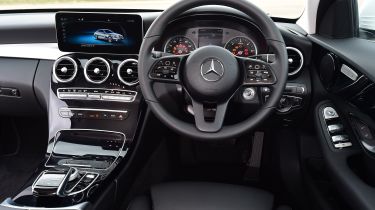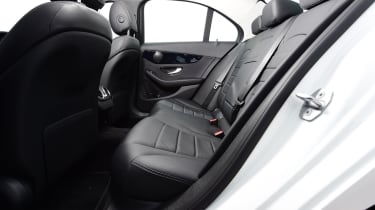Used Mercedes C-Class (Mk4, 2014-2021) - How practical is it?
The Mk4 Mercedes C-Class offers a good amount of room up front for driver and passenger, but the boot size is nothing special
The Mercedes C-Class Mk4 may not be for you if you’re after the roomiest possible used saloon car, although there is sufficient space inside for taller passengers and their luggage. Safety features across the board are pretty good and, while the more recent post-facelift models do benefit from more up-to-date tech, all models were fitted as standard with a handy amount of equipment.-
Dimensions, cabin and boot space
Size-wise, the Mercedes C-Class Mk4 is on par with its key rivals. At 4,688mm long, 1,810 wide and 1,442mm tall, the Mercedes takes up a similar amount of space on the road as the generations of Audi A4 it went up against at the time it was on sale.
However, while the exterior dimensions are about the same, that can’t quite be said for the interior of the C-Class. This is especially the case with rear-seat practicality; due to factors including the sloping roofline, there isn’t a huge amount of headroom on offer in the back of the Mercedes when compared with more spacious rivals such as the BMW 3 Series. Still, there is at least a decent amount of legroom. Thankfully, there’s plenty of space for the driver and the front seat passenger.
Boot space is also decent in the C-Class Mk4, if not spectacular by segment standards. At 455 litres, the C-Class’s cargo capacity is better than a Volvo S60’s (442 litres), but down on an Audi A4’s (480 litres). Do also bear in mind the boot capacity can vary, depending on the powertrain of the car you’re looking at. For instance, C200 models with the mild-hybrid petrol engine have a slightly reduced capacity of 435 litres, which falls to 300 litres on the plug-in hybrid C300e and C300de versions due to the way the battery pack is positioned underneath the boot floor.
Equipment and technology
Throughout the car’s lifecycle, the Mercedes C-Class Mk4 was available in three trim levels: SE, Sport and AMG Line. SE was the entry-level trim, and came as standard with a reversing camera, two-zone climate control, automatic windscreen wipers, cruise control and a seven-inch centre console display. When the C-Class was facelifted in 2018, the standard kit list on this trim was expanded to include adjustable suspension and a 10.25-inch screen to replace the original seven-inch item.
Used - available now

2015 Mercedes
C Class
63,503 milesAutomaticDiesel2.1L
Cash £12,693
2017 Mercedes
C Class
64,643 milesAutomaticPetrol2.0L
Cash £10,995
2019 Mercedes
C Class
41,392 milesAutomaticDiesel2.0L
Cash £17,000
2019 Mercedes
C Class
17,210 milesAutomaticDiesel2.0L
Cash £17,100Mid-range Sport trim level models came with broadly the same equipment as the SE trim, albeit with a few detail changes such as LED headlights, lowered suspension and more supportive front seats. At the top of the Mercedes C-Class Mk4 pecking order was the AMG Line trim, which injected a bit of AMG performance-car flavour to the regular car thanks to a more aggressive bodykit, firmer sports suspension, new interior features such as a sporty steering wheel and uprated brakes.
An array of features was also available across the Mercedes C-Class Mk4 range as optional extras. The selection of additional equipment was quite exhaustive, too: heated front seats, a head-up display unit, an upgraded sound system, blind spot monitoring and lane-keeping driver assists, an air suspension system, a 12.3-inch digital instrument display and even split-folding rear seats were relegated to the options list.
Safety
The Mercedes C-Class Mk4 was awarded a five-star safety rating when it was assessed by Euro NCAP in 2014. It performed especially well in adult occupant protection, with a score of 92 per cent in that category, and the C-Class still did well in the child protection (84 per cent), pedestrian protection (77 per cent) and safety tech (70 per cent) categories.
As standard, the Mercedes C-Class was fitted with a good amount of safety equipment. All cars came with seven airbags, a tyre pressure-monitoring system, a driver-attention monitor and an emergency braking-assist system that can automatically apply the car’s brakes if an imminent collision is detected. Optional safety equipment included a head-up display unit and blindspot monitoring.








